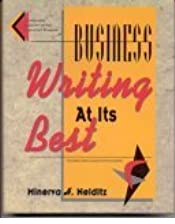 I recently stumbled upon material on business writing that was written by Minerva Heller Neiditz and published in 1993. Although the material needs some minor updating, I was surprised that much of it still applies today in business writing. Neiditz, who is presently 87 years old, wrote this book when she was 61. She’s written several books since; her most recent was published when she turned 85. Neiditz has a varied background that includes advanced degrees, politics, activism, professor, wife, mother, writer, and world traveler. But this is not the complete list.
I recently stumbled upon material on business writing that was written by Minerva Heller Neiditz and published in 1993. Although the material needs some minor updating, I was surprised that much of it still applies today in business writing. Neiditz, who is presently 87 years old, wrote this book when she was 61. She’s written several books since; her most recent was published when she turned 85. Neiditz has a varied background that includes advanced degrees, politics, activism, professor, wife, mother, writer, and world traveler. But this is not the complete list.
Her book “Business Writing at Its Best” (Irwin Professional Pub, 1993) is filled with commonsense material on how to write effective business correspondence. If you struggle with writing simple, effective business correspondence, take a page from the Neiditz business-writing playbook. Here are some highlights of her material. (The below outline is not verbatim from her book, and my comments are enclosed in brackets.)
1. When you write, write for your reader and not for yourself.
Ask yourself three questions:
a. Who is my audience?
b. What is the purpose of this writing?
c. How can I make the purpose clear to my audience?
2. When writing, use words that you would actually speak if you were talking to your readers face to face. Doing so will quash the temptation to use flowery words, extraneous words, and clichés, it will also diminish long-windedness.
a. Neiditz quotes Jonathan Price: “Clear writing is just talk put into ink.”
b. She asks her readers, “Would you speak these [letter openers and closers]?”
i. Per your request…
ii. In response to your inquiry…
iii. [and my all-time pet-peeve closing] Please feel free to call me.
3. Trust your ear as you listen to your voice amid the words in your communication.
If it sounds like something you wouldn’t normally say in day-to-day discussion, eliminate it.
4. Be clear and brief.
When you review your finished draft:
a. Eliminate “dead words” that have no meaning or are space fillers or flowery or extraneous.
b. Critique your flow, your tone.
c. Read your communication aloud and determine whether you would actually say these things if you were face to face with your audience.
5. Use plain English. [Henry David Thoreau penned the words: “Our life is frittered away by detail… simplify, simplify.” (To which it’s alleged that his friend, Ralph Waldo Emerson, responded, “Henry, wouldn’t one ‘simplify’ have sufficed?”)]
Some examples of fancy words/phrases that can be simplified:
a. Utilize (use)
b. Take into consideration (consider)
c. Retain (keep)
d. With the exception of (except for)
She concludes this chapter by suggesting using the shorter word over the longer, the concrete word over the abstract, and the familiar word over the esoteric.
The book goes on to cover such topics as:
- Readability
- Parallel construction in lists/bullets
- Verbs as the heart of the sentence
- Sections of a correspondence
- Persuasion
- Errors in logic
- Propaganda
- Grammar and punctuation
It’s an easy read and filled with useable information for any type of communication that needs to be written. It can be purchased through Amazon.
Let us know in the comment section below some of your favorite resources for writing business communications or tell us what your challenges are when you write business communications.




